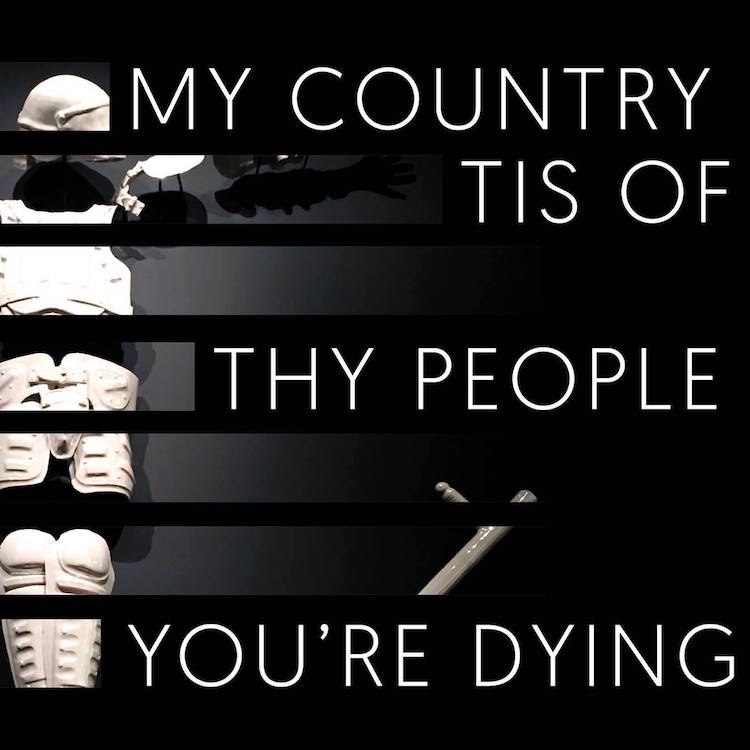NEW YORK — My Country Tis of Thy People…You’re Dying (March 31 – May 26, 2017) exhibition at Radiator Arts features artworks by contemporary Indigenous North American artists examining the United States’ relationally to Native tribes and concepts like land rights and ownership, forced relocation from traditional lands, unauthorized sale of tribal land and the environmental impact of energy extraction. But these aren’t merely ideas.
Indigenous peoples of the Western Hemisphere have a spiritual and mystical connection with the land. The land is part of the Indigenous tradition and religion, from creation stories, to the way in which Indigenous peoples live their lives—the land is indivisible from Native America.

Nicholas Galanin, God Complex, 2016, Mixed materials, dimensions vary

Nicholas Galanin, God Complex (detail), 2016, Mixed materials, dimensions vary
The exhibition draws in its name from the Buffy Sainte Marie song by the same name and explores how these issues impact the collective Indigenous psyche, as well as elucidites the political framework that has and continues to enable unsanctioned land deals and the abuse of powers over people.
With issues in recent years such as the sale of Oak Flat on the San Carlos Apache Reservation in Southeastern Arizona, First Nations tribes fighting pipelines through their territory, and most prominently the conflict at Standing Rock in North Dakota, the timing of this exhibition could not be more relevant.

Installation view

Installation view

Tom Jones, The North American, Landscape, 2013, 16 digital photographs. Each 20 x 20 inches
Hyperallergic writes, visitors are greeted by a ceramic bull skull by Cannupa Hanska Luger (Lakota/Mandan/Arikara/Hidatsa)
Its visage peers out beneath a messy mane of black fiber, dark glaze dripping from its empty eye sockets like tears, with steel horns wrapped in felt and rubber tire. The buffalo is remade in the oil industry’s image…

Cannupa Hanska Luger, At What Cost: Extraction, 2016, Ceramic and fiber

Cannupa Hanska Luger, At What Cost: Extraction (detail), 2016, Ceramic and fiber
Nearby are his Ceramic Knives, which invite visitors to pick-up them up, hold and explore.
…The fragility of their material belied by their weight and surface quality, which evokes flint blades and bone or antler handles. Their designs are influenced by tools used at Standing Rock and for his own everyday work, the clay taken directly from the earth.

Cannupa Hanska Luger, Ceramic Knives, 2016 Ceramic, dimensions vary

Cannupa Hanska Luger, Ceramic Knives, 2016 Ceramic, dimensions vary
The exhibition also features a film installation by Steven J. Yazzie (Navajo), which looks at the impact of uranium mining on the Navajo reservation, on the Navajo people, their health and the health of the land through stunning and poignant narrative and visual imagery; Nicholas Galanin’s (Tlingit) God Complex inspects the dynamics of power structures, the glorification of violence and police brutality, while redressing pop culture iconography with a religiosity, echoing Western society’s worship of material over life; Tom Jones’ (Ho Chunk) work, The North American Landscape, is a series of photographs of plastic toy trees. The work utilizes the trees as stand-ins for the landscape of North America and represents the areas American Indians continue to inhabit on this continent. It also comments on the destruction of the natural world replacing nature with manmade replicas; and a video installation ‘We are in Crisis’ by Winter Count Collective, which shows 2016 drone footage over Standing Rock. Roads and construction scar the treaty landscape, its flowing water shaded by oil derricks. The Dakota Access Pipeline has proven it’s detractors correct — it’s sprung three leaks since Donald Trump ordered it complete in January.
Text (edited) from gallery.
Do you love or loathe these works from the worlds of contemporary ceramics and contemporary ceramic art. Let us know in the comments.
Watch Winter Count Collective’s video here: We are in Crisis, 2016, Single channel video, 3min 2sec

Steven J. Yazzie, Mountain Song, 2015 Single channel video, 11min 11sec edition of 4

I would like to see this exhibition in Sarnia Canada (Ontario)